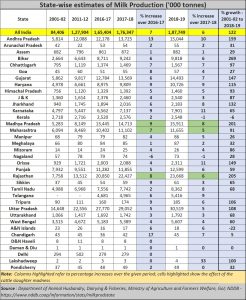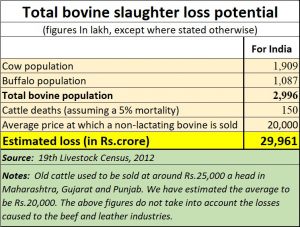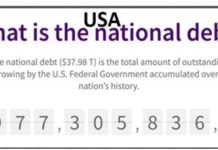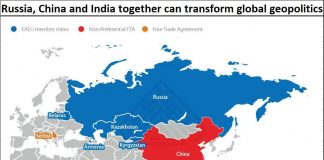A modified version of this article appeared at
https://www.moneycontrol.com/news/business/budget-2020-fm-sitharaman-proposes-doubling-milk-processing-capacity-by-2025-but-is-it-feasible-4933011.html
Budget2020 – Milk Processing: The government’s arithmetic concerning udders should give you the shudders
RN Bhaskar – 11 Feb 2020
“To build a seamless national cold supply chain for perishables, inclusive of milk, meat and fish, the Indian Railways will set up a “Kisan Rail” – through PPP arrangements. There shall be refrigerated coaches in Express and Freight trains as well.”
“Further, we shall facilitate doubling of milk processing capacity from 53.5 million MT to 108 million MT by 2025.”
Nirmala Sitharaman in her Budget speech (Paragraphs 23 (7) and 23 (14))
The Budget is a sacred document. One believes that the claims made in this document are made after careful study and deliberation. But it appears that someone has misled the finance minister, and even the government of India.
Take the statement made by the FM where she hopes to double milk processing capacity in India from 53 million tonnes to 108 million tonnes by 2025. Prima facie this flies in the face of milk production which stood at 187.7 million tonnes in 2018=19 (see chart). The figure has been obtained from the government’s own Department of Animal Husbandry, Dairying & Fisheries, Ministry of Agriculture and Farmers Welfare. This has been duly reported by NDDB (National Dairy Development Board) on its website (https://www.nddb.coop/information/stats/milkprodstate) .
 So is unprocessed milk reaching the market place?
So is unprocessed milk reaching the market place?
Though this sounds incredible, the fact is yes. Only 20% of the milk in India comes from the organised sector. The rest is through the unorganized sector. As a result, it is quite possible that 80% of the milk reaches the market in an unprocessed state.
But there is a problem when the FM wants to double milk processing capacity. Just look at the chart alongside. Milk production has ben increasing only at 6-7% each year. The FM wants processing capacity to increase at double this rate. Is this feasible?
It must also be noted that the food processing industry has not been given any financial incentive. Hence the flow of money into this sector will possibly be slow. Thus to expect processing capacity to grow at 15% year on year (it is only at 15% growth per annum that you can double capacity in five years’ time) appears a bit unrealistic.
There is a second problem. To get all milk into the organised sector will not be easy. Traders and middlemen will not want to lose their hold over unorganized farmers who are compelled to sell their milk at Rs.18-22 per litre compared to the Rs.26-36 paid by the organised sector. It may be recalled that when the government of Maharashtra tied up with NDDB to start a cooperative in Maharashtra and which became operational in October 2016 (http://www.asiaconverge.com/2017/02/nddb-and-dairy-farming-in-india/), the 30 odd cooperative dairies in the state (most politically well connected) were under immense pressure to increase their payment to farmers from Rs.20-22 per litre to Rs.26 per litre. This was lower than the Rs.32-36 per litre paid by Gujarat’s cooperatives. Maharashtra’s dairy cooperatives tried to disrupt milk supplies. And finally, the state government itself agreed to give these cooperatives a subsidy of around Rs.2 per litre to help them pay the Rs.26 per litre price to farmers.
A similar thing is happening in Uttar Pradesh too, where exploitation of farmers, and the hold of middlemen, is vicious.
 There is a third problem the FM has not taken into account. The rate of growth of milk production in India has begun to decline, even though the hunger for more milk is great. The one reason for this is the abhorrent cattle slaughter ban. Even if one were to concede that cow slaughter should be restricted, there is no justification for buffalo meat wagons be4ing stopped by vigilantes on highways, the drivers being beaten up, and sometimes killed. One does not have to be a genius to know thatt meat lying in the open air – when vehicles are stopped by vigilantes – is bound to putrefy. The trader thus sees the value of his consignment evaporate.
There is a third problem the FM has not taken into account. The rate of growth of milk production in India has begun to decline, even though the hunger for more milk is great. The one reason for this is the abhorrent cattle slaughter ban. Even if one were to concede that cow slaughter should be restricted, there is no justification for buffalo meat wagons be4ing stopped by vigilantes on highways, the drivers being beaten up, and sometimes killed. One does not have to be a genius to know thatt meat lying in the open air – when vehicles are stopped by vigilantes – is bound to putrefy. The trader thus sees the value of his consignment evaporate.
As a result, many traders refuse to pick up old cattle – buffaloes or cows – from farmers. Consequently, farmers who got Rs.20,000 to 25,000 per old cattlehead, now get nothing. Conventionally, the farmer used this money and added another Rs.20,000 (borrowed or through savings) and purchased another young cattlehead. This way his future milk earnings were assured. Now with the unsold old cattle, the farmer loses his income potential.
Not surprisingly, growth rates of milk production in India have begun to slow down. Milk production increased by 7% in 2017-18 over 2016-17. But the following year, it fell to 6%. The frenzied mob was now hurting the economy.
As a result, the biggest loser is the farmer. His community alone lost around Rs.30,000 crore each year (not counting the loss of future business). Worse, he had to pay for the upkeep of old cattle,
The farmer’s plight meant losses for the leather industry too, which employs huge numbers of people. Cobblers too were hurt. And so was the carabeef industry (http://www.moneycontrol.com/news/business/economy/some-red-flags-in-the-economy-numbers-agriculture-is-the-most-alarming-2477189.html). Thanks to this madness, the economy could be losing multiple times the Rs.30,000 crore farmers lost each year.
Expect the dairy industry to gradually drift to the eastern part of India. Most eastern states have refused to enforce cattle slaughter ban laws (it is a state subject). These stares have lots of foliage. It will enhance rural prosperity there. But it will take a few years more.
It is difficult to see the milk processing capacity grow in the face of these odds. The FM can be optimistic. But she must first back this optimism with money for more food processing industry plants. Without that, even refrigerated vans and wagons will become a fantasy – unaffordable and mere showpieces.
It may be recalled here, that during Verghese Kurien’s time, NDDB designed railway rankers which were insulated, not refrigerated, and which could take milk 2,000 km away, without losing more than 1.5 degrees of temperature inside. That was a realistic solution. |Today, Amul uses the railways extensively. Check out the GCMMF chairman’s speech at the 25th annual general meeting in 2009 (https://amul.com/m/chairman-s-speech:-35th-annual-general-body-meeting-held-on-5th-june,-2009 ), “We have also made giant strides by reaching out to millions of railway commuters by setting up more than 50 Amul stalls across major railways stations of the country. The Indian Railways has also recognized our efforts, and with active support from IRCTC we plan to set up another 300 parlours during the coming year. “
Refrigeration as a solution needs a lot more value addition. This requires huge investments in food processing. The budget hasn’t made any provision for incentives for this sector. Without food processing, refrigeration may become another pipe dream.










































COMMENTS